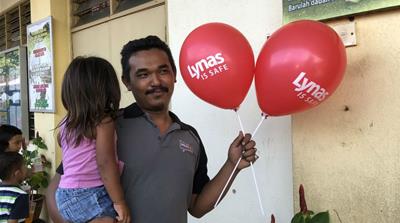Controversial rare earths plant in fight for survival in Malaysia
Kuantan, Malaysia – The Lynas rare earths processing plant on Malaysia’s east coast, a major producer of the elements vital for mobile phones and other gadgets, is facing a battle for survival as the country’s new government investigates the facility’s waste management policies and environmental impact.
The government, which won the general election six months ago, announced in September it would probe long-standing environmental concerns surrounding the six-year-old plant and how it handles the radioactive waste created during processing.
The previous government, which had ruled Malaysia since it gained independence from Britain in 1957, backed Lynas despite public opposition and also granted the company a 12-year tax holiday.
The review committee will submit its report early next week, but the Ministry of Energy, Science, Technology, Environment and Climate Change said there was no timeline for when the government would announce its decision.
 |
| A security barrier near the entrance of the controversial Australian-owned Lynas plant [Al Jazeera] |
In recent weeks Lynas, a company listed on the Australian Stock Exchange, has been on a publicity blitz, placing a series of advertorials in newspapers and online news outlets to defend its operations.
The processing facility runs on a philosophy of “zero harm” according to the advertorials, urging “fairness, objectivity and transparency” in the review.
The controversy
The Lynas plant in Malaysia was set up despite opposition from environmentalists, activists and local residents, some of whom went to court in an ultimately unsuccessful bid to stop Lynas’s operations.
Their fears were shaped partly by what had happened at an earlier rare earths refinery near the town of Bukit Merah in the central state of Perak.
Residents there blamed the facility, part-owned by Mitsubishi Chemical, for an elevated number of birth defects and leukaemia cases.
The plant was eventually shut down in 1994 after more than 10 years, and Mitsubishi Chemical has so far spent an estimated $100m to clean up the site.
Lynas rejects comparisons with Bukit Merah and insists its waste is far less harmful. The residue in Bukit Merah was more than 60 times more radioactive than the waste produced by Lynas, the company said.
Recycling vs disposal
The other major concern is the lack of a comprehensive long-term plan to deal with the plant’s radioactive waste.
 |
| Residents and activists held mass protests against the construction of the Lynas plant, but the development still went ahead [Bazuki Muhammad/Reuters] |
Lynas says it will turn the waste into a soil conditioner called CondiSoil, removing the need to build a permanent disposal facility.
It insists the plan is “in line with internationally accepted principles of residue management”.
CondiSoil has been tested by a Malaysian university and an agricultural institute in research funded by Lynas.
Fuziah Salleh is a member of parliament from Kuantan, 30km from the plant. She has opposed Lynas from the start and says the studies have only looked at “CondiSoil’s effects on plants, but not on the people who eat the plants”.
Gavin Mudd, RMIT University Melbourne professor of environmental engineering, told Al Jazeera if Lynas were doing its processing in Australia it would be subject to “a greater degree of environmental assessment and have to go through much more stringent public consultation”.
‘Scientifically proven’
The plant employs about 600 Malaysians, some of whom turned up at a recent public hearing to show their support for the company.
“As a worker, of course I’m concerned, but it’s scientifically proven that it’s safe,” Yasmin Hazlin, an engineer at the facility, told Al Jazeera. “And if anything were to happen, I’ll be one of the first to be affected.”
Shaharuddin Shamsudin, a community leader in Balok, the town nearest the site, says he supports the government review, but ultimately believes Lynas has brought more good than harm.
“I want community development,” Shaharuddin said. “If there’s a good project, let it be.”
At the hearing, government agencies including the Department of Environment and Malaysia’s nuclear agency, the Atomic Energy Licensing Board, gave glowing accounts of how Lynas had complied with all relevant rules and regulations.
 |
| Lynas CEO Amanda Lacaze talks to Kuantan MP Fuziah Salleh who has campaigned against the rare earths plant since the beginning [Florence Looi/Al Jazeera] |
“The reason why each of the regulating bodies spoke positively is they are the ones who actually receive our measurement packs, our reports,” said Lynas’ CEO Amanda Lacaze. “They’re the ones who inspect what we do. They’re the ones who audit.”
Fuziah is sceptical.
“They [agency officials] have to defend the decision that they made in the previous administration,” she said.
‘Guinea pigs’
 |
| Lynas has gone on a publicity offensive as Malaysia’s government reviews its operations. Here, a man and his child attend a Lynas-sponsored event at a local school [Florence Looi/Al Jazeera] |
Whatever Malaysia’s government decides to do about Lynas, it’s likely to have geopolitical implications since there are so few rare earth producers.
China’s decision to limit domestic rare earths production in the second half of this year is likely to drive up prices, according to Adamas Intelligence, a research firm that tracks the industry.
The US’s moves to exclude the elements from import tariffs in its continuing trade dispute with China only underlines their importance.
But those who have concerns about the Lynas plant say health and safety must come first.
As Nandakumaran Kathirvaloo, a retired school principal, told the government committee, “We don’t want to be guinea pigs. We don’t want you to say 20 years later, ‘Oops. Sorry, we made a mistake.'”




